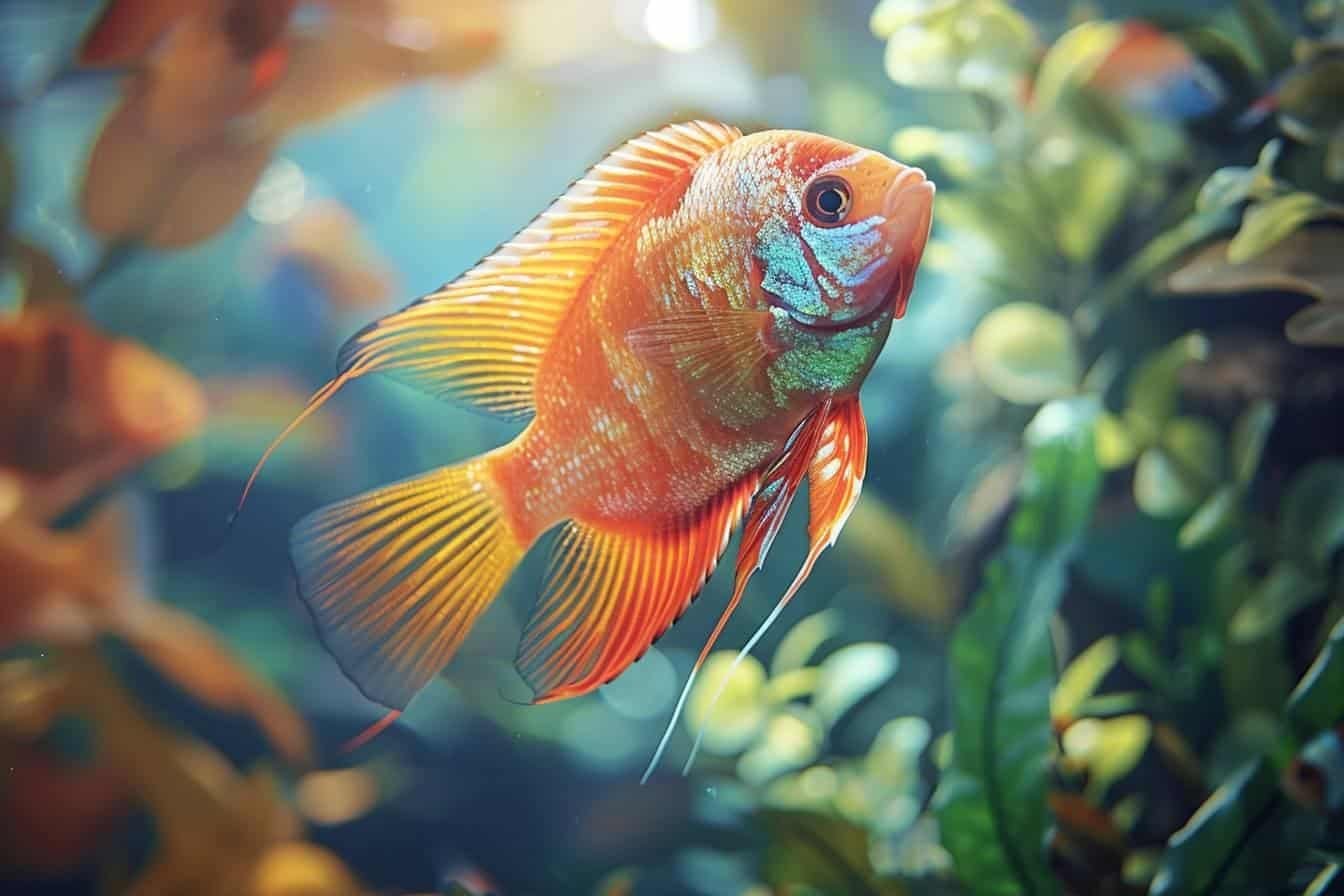Ah, the telescope fish ! A real little aquatic jewel that's sure to turn heads in our aquariums. As a pet shop assistant for over 10 years, I've seen quite a few fish, but this one is still one of my favourites. Let me guide you through the fascinating world of this cyprinid with protruding eyes that has delighted aquarists for centuries.
History and characteristics of the telescope fish
Le telescope fish was not born yesterday, far from it! Originally from China, it first appeared in the 16th century. It wasn't until the 19th century that it arrived in Europe, in 1872 to be precise. In the meantime, our Japanese friends had a field day selecting and breeding it, creating numerous varieties.
Physically, this fish is surprising. Its bulging, protruding eyes give it a slightly bewildered look that is the source of its charm. Its ovoid or round body is topped by veiled fins, and its forked tail is often longer than the rest of its body. A real little seabed model!
In terms of size, don't expect a monster of the deep. The telescope fish grows to an average of 15-20 cm as an adult, with the luckiest specimens reaching 30 cm. And when it comes to longevity, hang on to your hat: these little guys can live between 10 and 15 years on average, with some even reaching 25-30 years! Enough to see you through the rest of your life.
A rainbow of varieties
If you think all telescope fish look the same, think again! There are a multitude of varieties and colours. Here's a little anecdote on the subject. One day, a customer came to me asking for a "black telescope fish". I thought he was joking, but no! He was talking about the famous Black Moor. Since then, I've got to know the whole range:
- The Black Moor, dressed all in black
- Orange, for a vitamin-packed look
- Red, classic but effective
- White, elegant for all occasions
- The panda, for lovers of originality
- Calico, a veritable aquatic patchwork
Eyes that speak volumes
Let's talk about those famous eyes, the real stars of the show. Unfortunately, this physical peculiarity is not without consequences. Telescope fish have limited vision, and it's not uncommon for them to go blind around the age of 2-3. It's as if Mother Nature decided to give them permanent sunglasses, but without the lenses!
Behaviour and needs of telescope fish in aquariums
Now that we've made the introductions, let's talk a little about the personality of our big-eyed friend. The telescope fish is a real gentle giant of the aquarium. Peaceful and gregarious, he gets on with everyone... or almost everyone!
A golden character
Despite its slightly clumsy appearance, the telescope fish is a real heart on fins. They are easy to tame and can even learn to recognise their owner. I've seen telescope fish come to 'greet' their master every time they passed in front of the aquarium. A real little aquatic dog!
When it comes to swimming, don't expect Olympic performances. With its limited vision and rounded body, the telescope fish moves slowly and sometimes awkwardly. It's a bit as if it were constantly taking its first steps after a drunken evening.
An ogre's appetite
Now let's talk about what tickles the taste buds of our telescopic friends. These little gourmets are omnivores and love to eat. They need to be fed in small quantities several times a day. It's a bit like having a teenager in the house who's constantly dipping into the fridge!
Here is a summary of their diet:
| Type of food | Frequency | Quantity |
|---|---|---|
| Special flakes | 2-3 times a day | Small pinch |
| Granules | Once a day | 2-3 granules per fish |
| Fresh food (worms, artemia) | 1-2 times a week | Small portion |
Tailor-made housing
To ensure that your telescope fish feels like a fish in water (no pun intended), you need to provide it with a suitable environment. An aquarium of at least 50 to 100 litres per fish is recommended. It's like giving each of your fish a loft!
The ideal temperature is between 18 and 24°C, with a pH between 7 and 7.5. Beware, these fish are sensitive to sudden changes, so avoid cold showers or boiling baths!
Don't forget good filtration and effective oxygenation. It's a bit like installing an air conditioning and air purification system in your flat. And to keep the water clean, plan regular water changes (10-25% per week).

Health and reproduction of telescope fish
Like all living creatures, telescope fish can have their little health concerns. They are particularly sensitive to disease and dirty water. It's a bit like the hypochondriac of the aquarium! Clean water and stable parameters are essential for their health.
When it comes to reproduction, these little fish are like aquatic rabbits. A female can lay between 300 and 2,000 eggs per clutch. Just imagine the baby boom in your aquarium! If you want to start breeding them, make sure you have enough room to accommodate all their offspring.
In fact, if you're interested in aquarium fish reproduction, you might be curious to know how to tell the difference between male and female molly fish. It's always useful when you want to play aquatic matchmaker!
Telescope fish: an investment worth the cost?
So, are you ready to adopt a telescope fish? The price can vary considerably depending on the variety. Specimens can be found for as little as a few euros, but rare varieties can fetch astronomical sums, sometimes in excess of €2,000! It's a bit like choosing between a Twingo and a Ferrari, but in an aquatic version.
Personally, I think they're well worth the effort. These little creatures with their bulging eyes add a touch of originality and life to any aquarium. And let's face it, it's a lot more fun to tell your friends that you've got a telescope fish than just a goldfish!
If you're ready to embark on the adventure of telescope fish in aquariumSo don't hesitate to find out more. And who knows, maybe soon you too will be spending hours gazing at these clumsy but endearing little swimming balls.
And if you're ever in the mood to think even bigger, why not consider a aquarium for koi carp ? After all, when you love it, you don't count... well, except when it comes to changing litres of water every week!
External sources :
